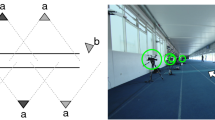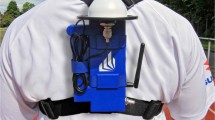Abstract
Accurate sprint-related information, such as stride times, stance times, stride lengths, continuous Centre-of-Mass (CoM) displacements and split times of sprinters are important to both sprint coaches and biomechanics researchers. These information are traditionally captured using camera-based systems which are very expensive and time-consuming to setup. This paper investigates - through a series of experiments - whether an integrated sensing system would provide a practical, cost-effective alternative to measuring stride-related information of sprinters. The results show that the system achieves an accuracy within 5ms for stance time and stride time measurements, and ~10cm for localisation-related information such as CoM forward displacement and CoM stride displacement (i.e. stride length).
Access this chapter
Tax calculation will be finalised at checkout
Purchases are for personal use only
Preview
Unable to display preview. Download preview PDF.
Similar content being viewed by others
References
The SEnsing for Sports And Managed Exercise (SESAME) project, http://www.sesame.ucl.ac.uk
Cheng, L., et al.: Analysis of Wireless Inertial Sensing for Athlete Coaching Support. In: Proceedings of IEEE Global Communications Conference (GLOBECOM), New Orleans, USA (December 2008)
Cheng, L., et al.: A Low-cost Accurate Speed Tracking System for Supporting Sprint Coaching. Accepted for publication in the Proceedings of the Institution of Mechanical Engineers, Part P, Journal of Sports Engineering and Technology
Tan, H., Wilson, A.M.: Measurement of stride parameters using a wearable GPS and inertial measurement unit. Journal of Biomechanics 41, 1398–1406 (2008)
nanoLoc Development Kit v1.4, nanotron Technologies, http://www.nanotron.com/EN/PR_nl_dev_kit.php
CODAmotion, http://www.codamotion.com
Charnwood Dynamics Ltd., CODA cx1 User Guide (2006)
Kranz, M., Spiessl, W., Schmidt, A.: Designing Ubiquitous Computing Systems for Sports Equipment. In: Proceedings of IEEE PerCom 2007, pp. 79–86 (2007)
King, R., et al.: Body Sensor Networks for Monitoring Rowing Technique. In: Proceedings of the 6th IEEE International Workshop on Wearable and Implantable Body Sensor Networks, CA, USA (June 2009)
Mann, R.: The Mechanics of Sprinting. CompuSport, Orlando, FL (1990)
Qualisys, http://www.qualisys.com/
Chi, E.: Introducing Wearable Force Sensors in Martial Arts. Pervasive Computing Magazine 04(3), 47–53 (2005)
Courtesy Ferro, A., Rivera, A., Pagola, I., Ferreruela, M., Martín, A., Rocandio, V.: Biomechanical Analysis of the World Championships in Athletics Sevilla’99: 100, 200, 400m sprint events. New Studies in Athletics 16(1/2) (2001)
Baker, J.S., Davis, B.: High intensity exercise assessment: relationships between laboratory and field measures of performance. Journal of Science and Medicine in Sport 5(4), 341–347 (2002)
The gumstix computer, http://www.gumstix.com/
Li, L., Kunz, T.: Localisation Applying an Efficient Neural Network Map**. In: Proceedings of the 1st International Conference on Autonomic Computing and Communication Systems, Rome, Italy (2007)
Shen, Y., Cai, Y., Xu, X.: Localized Interference-aware and Energy-conserving Topology Control Algorithms. The Proceedings of Wireless Personal Communications: An International Journal 45(1), 103–120 (2008)
Song, B., Lee, H., Chung, K.: Toward A Totally Solving Interference Problem for Ultrasound Localization System. In: The Proceedings of Optical Internet and Next Generation Network (COIN-NGNCON), Jeju, South Korea, July 2006, pp. 162–164 (2006)
Author information
Authors and Affiliations
Editor information
Editors and Affiliations
Rights and permissions
Copyright information
© 2010 Springer-Verlag Berlin Heidelberg
About this paper
Cite this paper
Cheng, L. et al. (2010). Sensing for Stride Information of Sprinters. In: Silva, J.S., Krishnamachari, B., Boavida, F. (eds) Wireless Sensor Networks. EWSN 2010. Lecture Notes in Computer Science, vol 5970. Springer, Berlin, Heidelberg. https://doi.org/10.1007/978-3-642-11917-0_10
Download citation
DOI: https://doi.org/10.1007/978-3-642-11917-0_10
Publisher Name: Springer, Berlin, Heidelberg
Print ISBN: 978-3-642-11916-3
Online ISBN: 978-3-642-11917-0
eBook Packages: Computer ScienceComputer Science (R0)




